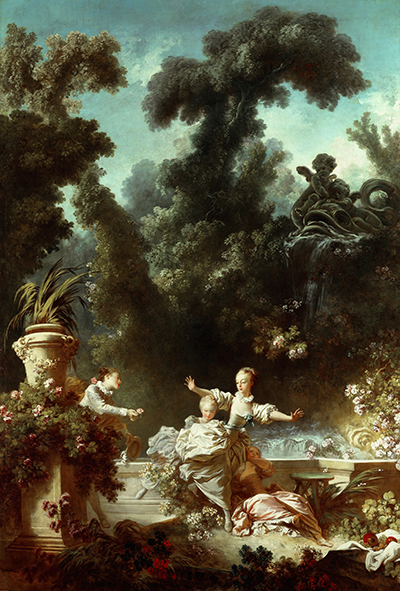 Buy Art Prints Now
Buy Art Prints Nowfrom Amazon
* As an Amazon Associate, and partner with Google Adsense and Ezoic, I earn from qualifying purchases.
The Progress of Love: The Pursuit came from the career of Fragonard, a French painter who used romance as an inspiration for many of his most famous paintings.
A young lady outstretches her arms whilst perched on a stone wall. A beautiful vase is sat to their right, our left, and in the nearest foreground Fragonard adds darkened flowers which help to avoid an abrupt edge to the bottom of the painting. The light is spread between the main figures in this painting plus the bright sky which appears at the very top. In between are further flourishes of trees and plants that help to complete the environment of an upper class, 18th century garden, the like of which very few would have been able to even see during that time, let alone own within their own property One could argue that not much has changed, some two and a half centuries later. Keeping with the intended order of this series, Fragonard gave us The Pursuit, The Meeting, The Lover Crowned, then finishing with The Love Letters.
Fragonard was frequently using romance as inspiration for his work but within this series it was particularly prominent. The four iterations were also styled fairly similarly, with a clear visual consistency lying throughout. He would have considered the project as a whole before starting the first piece, so that initial decisions would not cause issues when starting the later pieces. The whole set was completed during the years of 1771 to 1773. Fragonard's career was not initially very well documented and so even individual pieces are dated loosely across several different years as one cannot be any more precise than that. We should also remember that two and a half centuries have passed since this period, and so we cannot expect quite as much information to be available as compared to artists from more recent art movements.
The four artworks would later be purchased by the Frick family and eventually installed in a room which was designed purely for them. This collection can be enjoyed within New York, a city which itself has a number of high profile art institutions and remains a must-visit location for those looking to study original art, whatever the period. With regards the work of the Fricks, their collection has continued to grow over many generations and now also includes a substantial library which would be of great use to academics looking to study art history in further detail. Many of its publications are no-longer available anywhere else. If you make a visit to this venue, you will also be able to enjoy original paintings from the likes of Baptiste-Camille Corot, Jacques Louis David, Joseph Mallord William Turner and Jacopo Tintoretto.



